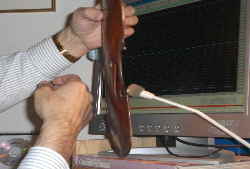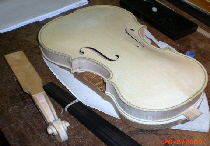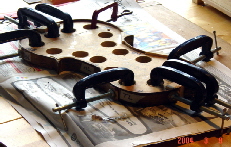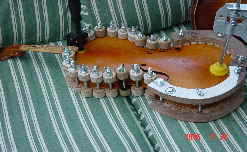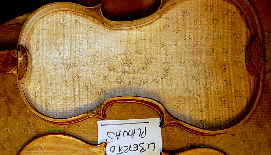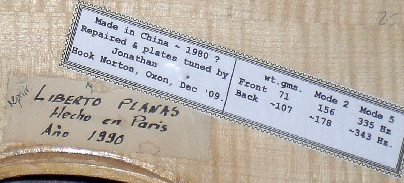|
15 1/4” (387 mm.) Viola 
Ken, a violinist friend, wanted me to take custody of a rather sad old 15 1/4” viola he'd been given. It hadn't been played for 10's of years, and had telltale worm holes in the front and a bout.
Taking the front off, the belly had an intrinsic bassbar (click picture above) and worm along the centre line. I fitted 5 spruce patches (see below) and increased the gluing area of the land for the top block 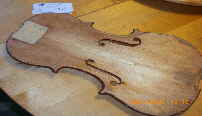 and thinned the plate to: centre (between ffs) 3.1 to 3.3 mm, sound post area 3.5 mm, top and bottom areas to 2.8 - 2.9 mm thick. This gave a belly that was 88 gms, Mode 2 = 111 Hz, and Mode 5 = 241 Hz. This is very low indeed for Mode 5, but a good tall bassbar might just get it to a useable Stiffness Factor, so I fitted and shaped a 17 mm (max.) bassbar. A Strad Magazine article and thinned the plate to: centre (between ffs) 3.1 to 3.3 mm, sound post area 3.5 mm, top and bottom areas to 2.8 - 2.9 mm thick. This gave a belly that was 88 gms, Mode 2 = 111 Hz, and Mode 5 = 241 Hz. This is very low indeed for Mode 5, but a good tall bassbar might just get it to a useable Stiffness Factor, so I fitted and shaped a 17 mm (max.) bassbar. A Strad Magazine article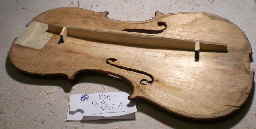 (Jo Curtin?) in 2009 suggests a tall bassbar can be ok on a viola. (Jo Curtin?) in 2009 suggests a tall bassbar can be ok on a viola.
So the new bassbar looks like this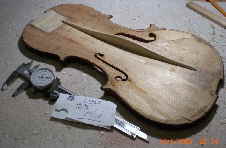 ........, and it is shaped according to “The Art of Violin Making” by Courtnall and Johnson instructions for a good bassbar. ........, and it is shaped according to “The Art of Violin Making” by Courtnall and Johnson instructions for a good bassbar.
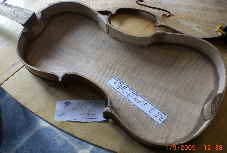
The back was thinned to a thickness pattern with a good thick area between the C-bouts to keep Mode 2 up, and the corner blocks were ‘filled in': see right. The back's Stiffness Factor was taken really low to 0.93: as low as I dare take it, as the front is at 0.82. I sanded the ribs down to 1.2 mm with a Dremel sanding bit.
The spreadsheet showing how the Stiffness Factors are calculated can be found here, and is summarised in the table below:
|
Ssheet 387mm viola SFs V1.0.xls
|
8 Jan '10
|
|
|
|
|
Stiffness Figures are for fully finished plates with varnish
|
|
Belly ref. Weight (gms.)
|
76.5
|
Belly Stiffness Figure: Reference
|
4,500,000
|
|
Back ref. weight (gms.)
|
129
|
Belly Stiffness Figure: Reference
|
7,580,000
|
|
|
|
|
|
|
|
|
Weight (gms.)
|
Mode 2 (Hz)
|
Mode 5 (Hz)
|
Stiffness Factor
|
|
Belly
|
96
|
133
|
281
|
0.82
|
|
Back
|
146
|
148
|
305
|
0.93
|
|
|
|
|
relative to Stiffness Figures above
|
With the viola reassembled - belly and fingerboard put back on, a new 47 mm. bridge, 6.5 mm sound post and strings fitted the first impression was that this is a very very good instrument, and well suited to a student for chamber and orchestral playing. The tone is even between the strings - even the G string where there is often a one-note boom. It has an amazing C-string, considering this is just a 15 1/4” viola! Bowing is so easy that Irish dance jigs etc. sound really good on it, and the notes can be articulated easily.
So even with such low Stiffness Factors this is the best viola I have played outside the BVMA exhibition in London!
|
